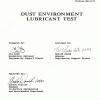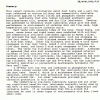From bbobynski on
www.bobistheoilguy.com
One thing I can touch on and clear up.....the GM oil life monitor operation and my statement that ZDP (or ZDDP as you tend to call it here...most of the API literature just sticks to ZDP so I tend to use that) depletion is the basis for oil deterioration.
My spelling is poor but ZDP stands for zinc dialkyldithiophosphate which , as it sounds, is an anti-wear compound comprised of zinc and phosphorus.
ZDP is dispersed in the oil so as to be at a potential wear site if a surface asperity happens to break thru the oil film thickness causing the dreaded metal-to-metal contact. A molecule of ZDP must be present at that moment to prevent microwelding at the contact site which will cause material transfer, scuffing, scoring, wear and catostrophic failure. The concentration of ZDP in the oil will determine if there is ZDP present to work it's magic. The greater the concentration...the more likely a molecule of ZDP will be there...and vice versa.
By nature, ZDP is sacrifical. As ZDP is "used up" at a wear site to prevent micorwelding the concentration of ZDP decreases.... So...if you measure the ZDP concentration in engine oil in a running engine it will decrease at linear rate based on engine revolutions. Any given engine has a certain number of high potential wear areas where metal-to-metal contact could occur due to reduced film thickness and/or surface asperities....areas such as rubbing element cam followers, distributor gears, rocker arm pivots, push rod tips, etc...... The more of these areas the more ZDP depletion. The more often these features come in contact the greater the ZDP depletion. That is why, generally speaking, ZDP concentration in the oil, for any given engine, will decrease at a fairly linear rate when plotted versus cummulative engine revolutions. The more times it turns the more contact the more chance for wear the greater the depletion. This is as much of a fact as I could quote ever and is really not speculation or anything. It is proven beyond a shadow of a doubt in many studies. That is why it is ONE of the basis for determining oil life remaining and why it is THE basic premis of the GM oil life algorithm. It is only ONE of the things that determines oil life...but it is the one thing that can be tied to engine operation in a linear fashion and estimated very accurately by accumulating engine revolutions via a counter.






